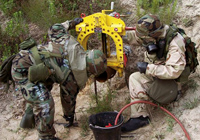 |
 |
| 177th Liquid Fuels Airmen repair a fuel line in 80 plus degree heat. Photo by Tech Sgt. Robert Campbell, 823RED HORSE |
That was one of the comments overheard when the 52
members of the 177th Fighter Wing Civil Engineer Squadron
and 13 Services Flight Guardsmen boarded a C-130 and
deployed to Tyndall Air Force Base, Fla., for a Silver Flag
Exercise.
From July 15 until July 22, the 177th along with the Civil Engineers from other Guard and active-duty Air Force units received four days of contingency training – training geared toward deploying to a hostile environment.
“The equipment and instruction provided by the Cadre
was exceptional,” stated Chief Master Sgt. Donald E.
Harris, NCOIC Civil Engineering. “Everyone got the opportunity
for hands-on training on equipment they would see in
a deployed location.”
All Guard, Reserve and Active-Duty Civil Engineer units must attend a Silver Flag Exercise every 45 months to be tested on their war skills by the 823rd RED HORSE (Rapid Engineer Deployable Heavy Operational Repair Squadron Engineers) to ensure that they are worldwide deployable.
One thing that had changed was the involvement of non-CE units. “There were active-duty communications, finance and contracting shops involved in the exercise,” noted Maj. James Layton Jr., 177th CE Commander. “This was a reflection of the real world where previous Silver Flag exercises treated CE and Services as working by themselves, when in reality it is just the opposite.”
On War Day, beginning at 5 a.m. and ending 15 hours later, every major Civil Engineer function was exercised. It also became an endurance test as well; almost everyone spent at least three hours in their chem gear while the temperatures were in the high 80’s.
While Explosive Ordnance Disposal cleared and removed
all unexploded bombs, Readiness established a
perimeter and performed chemical testing to determine if
the site was contaminated. In turn Site Development laid
out the entire base camp so all the other sections knew
where the different equipment needed to be placed on the
airfield and Structures troops built numerous types of Small
Shelter System tents to include warehouse size structures. Next, the Utilities Airmen installed the water purification
unit, the shower and latrine facilities and performed
pipeline repairs to the base fuel supply system.
The Power Production team operated and maintained
the different emergency generators needed to provide
power to the base. They also installed a Mobile Aircraft
Arresting System on the airfield to allow fighter aircraft to recover. Electrical workers ran all the primary and secondary
cabling and switch gear required to power the facilities
including the Airfield Lighting System which allows the
planes to land at night, while the Heating, Ventilation and
Air Conditioning Airmen installed air conditioning and setup
the refrigeration in the dining facility and Morgue.
Meanwhile the Heavy Equipment folks cleared and
filled two bomb craters on the airfield – no easy task
involving front end loaders, graders, rollers, dump trucks, a
water truck and sweepers.
The Firefighters performed aircrew extractions and extinguished numerous aircraft fires.
The 13 Services Flight Airmen were tasked with developing
a lodging plan for the 190 personnel involved in War
Day; setting up and running the dining facility and food
preparation area; operating a Morale, Welfare and Recreation
tent; and collecting and processing remains.
Typical of the comments made by the 823rd RED
HORSE was the statement: “They completed each step
with ease quickly and efficiently. They finished well before
the time was up. You can tell this was well-taught in Home
Station training.”
“It used to be new but now with having so many guys
deployed to Iraq and Diego Garcia this has become old
school to us now,” stated Senior Master Sgt. Thomas
Maurer, Operations NCOIC, 177th Civil Engineer Squadron. “We are a lot more familiar with it, so it’s to the point
where some of us can go to the schoolhouse and start
teaching this stuff.”
 |
Volume 32 Number 4 Staff / Information |
 |